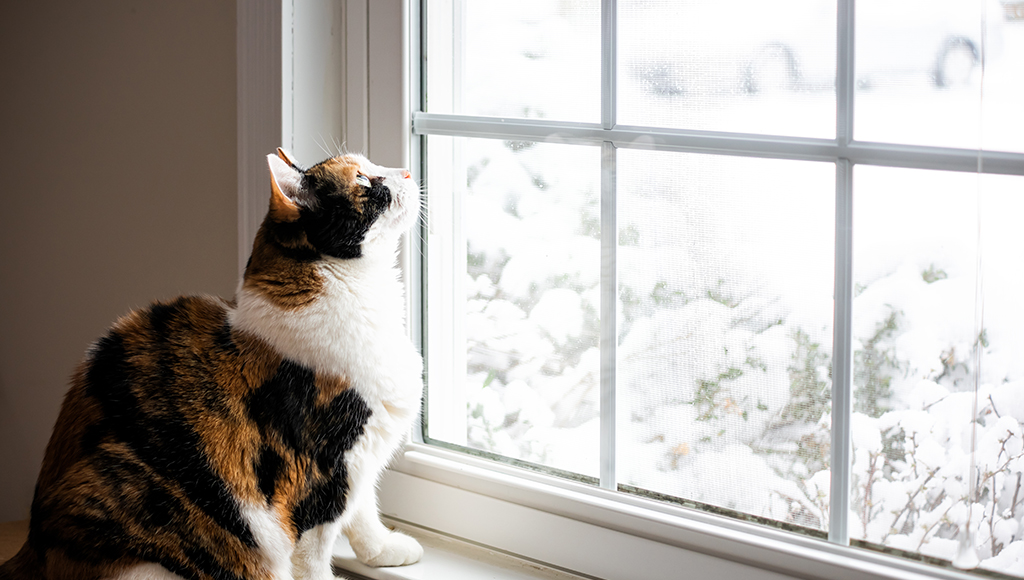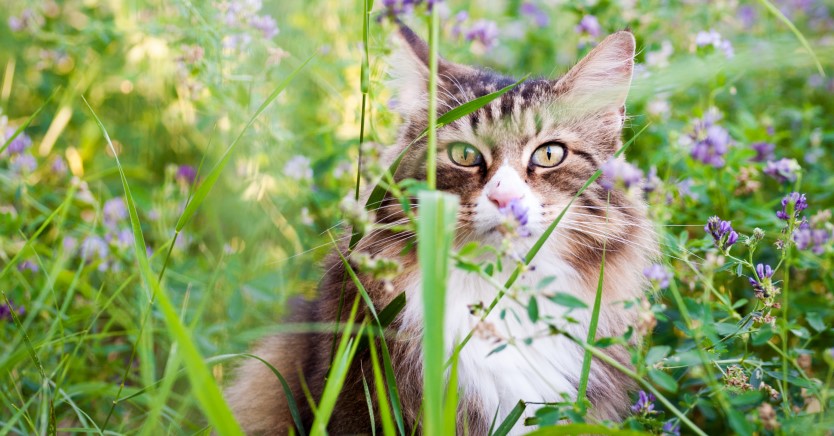Do Cats Get Cabin Fever in Winter?
Cats are influenced by the climate of deep winter-possibly mirroring our own changes and moods.

The winter months influence us in subtle ways. The relative lack of daylight and persistent cold have a way of dampening our activity level as well as our mood. Our pets are also influenced by the climate of deep winter-possibly mirroring our own changes. And, like us, they may start to feel restless and bored. One consequence of cabin fever may be a new behavior problem or two. Luckily, you can use your own resources and imagination to counteract the darkness for yourself and for your pet. Below are some suggestions for fighting the deep winter blues.
The safest environment for cats, year-round, is indoors. But even those who spend part of their day outside may find the outside door locked to keep winter's cold at bay. If your cat is accustomed to outdoor time, it should be fine to let her out for at least short periods, even in January. Rather than let her out and wait for her to return on her own, it might be best to call her after a few minutes to make sure she has not gotten too far from the house, especially when expecting the weather to take a quick turn for the worse.The greatest risks of cold weather are wind and precipitation; as long as you avoid days of dipping wind chill and provide an accessible shelter, your veteran yard dweller will probably appreciate some outdoor time and be able to handle it on her own for short periods without any problems. However, make sure you only let her out when you are also around to let her in. She may get chilled, or a quick storm may blow up suddenly. Don't take any chances!
Try to overcome the worry that a sleeping cat is a bored cat. Sleeping can also be a sign of contentment. Cats are likely to sleep more during the winter months so don't be alarmed, unless your cats sleeping begins to become too extended where she starts missing meals, or refusing to drink or play; this may be a sign of a problem that needs to be addressed. Let sleeping cats lie-preferably in a sunny spot. In these darker months they will appreciate any extra access you can provide to a cozy spot to sleep in the sun. A window seat is a great idea and can be purchased at any pet store. It provides a warm, sunny place for your feline, plus a great view of the outdoors to watch birds and activity which helps to entertain them. To make the window seat even more appealing, place several bird feeders just outside your window where the cat perch is located so your cat can observe the action. Although birds may be leery of your little predator's gaze at first, they will soon learn to ignore him. The birds will really appreciate the food during the winter, too.
Don't assume your cat will benefit from a busy social calendar. Unlike dogs, who tend to prefer the company of their owners rather then the familiarity of their home, cats are happiest in their own environment. Don't take them visiting, nor feel as though you need to bring them extra visitors, as cats are solitary creatures who prefer attention in small doses on their terms.
Who can resist a new toy? The Internet and pet supply stores offer a wonderful variety of playthings for cats. Keep a well-stocked box of cat toys (out of view) to provide diversion when it is needed. Among the favorites: bell balls, fleece remnants, crumpled aluminum foil, a rag pulled by a long string (toys with strings are dangerous when swallowed, and should be used only under direct supervision) and Ping Pong balls. Don't just leave the toys laying around for kitty to pounce on as they'll lose interest; instead put them away and take them out frequently to have fun playing with your cat. This will give both of you something fun and fresh to look forward too, and is a great time to bond further with your favorite feline. A frequent belief of animal behaviorists is that playthings must be novel to be interesting. So whatever toys you make or buy for your cat will be most useful if they are put away when not in use. This is particularly true for "prey" toys such as dangling feathers or rags, which can animate even the most sluggish cat.
Catnip has interesting effects on cats, and most cats seem to enjoy it. Buy some loose catnip and offer an occasional sprinkling on the floor. This will get your cat's attention and stimulate his playfulness.
As a harbinger of spring, offer your cat fresh herbicide-free grass to munch. Plant organic grass seeds in a row of small pots. When the sprouts reach two to three inches, offer one pot to your pet, and replant with fresh seeds when she's done with her salad. This way, you will always have a snack of greens available for your cat. You can also try hiding small treats here and there in your cat's favorite room. A pinch of catnip or a few kernels of a wholesome and healthy cat snack will be welcome discoveries for your adventurous feline.
Try teaching your cat a simple trick. You might be surprised at what cats can learn when they are rewarded with good treats. Tasks such as jumping over a stick or through a hoop, or simply sitting when asked, can be easily taught when food treats are used as a physical lure. Offer the treat immediately when the cat does what you want him to do, and he will soon learn. When taught with positive reinforcement and short sessions (always ending on an upbeat note), even older cats love learning new tricks. And even if your cat doesn't learn the trick, he'll enjoy the time spent interacting with you.
Build a cat tree for your cat. Start with a floor-to-ceiling beam and add two to three horizontal shelves and at least one box. Cover all with carpet remnants or thick-coiled rope. Placed by a window, cat trees provide a lasting source of exercise and fun, and they make a terrific napping perch. If you don't have the resource available or the time to build a cat tree, provide a variety of scratching posts that your cat will actually use. Although each cat is an individual with her own scratching interests, many cats enjoy horizontal corrugated cardboard scratchers (available at many pet supply stores) and anything wrapped with rope. Go for a mixture of horizontal and vertical posts, and see which ones your cat likes best. Place these posts in central locations or near any place you've witnessed your cat scratching in the past.
Spend extra time grooming the loose hairs from your cat. These "nesting" months offer a great opportunity to reintroduce routines for which you seem to have run out of time.
Helping kitty to combat his winter woes will help you combat yours as well, and before you know it, winter will be melting away!
Ready to start saving money on pet wellness care?
Then take a look at Mint Wellness, the pet wellness plan that provides fast reimbursement on routine pet care. Save on vaccinations, wellness exams, preventatives, dental, and more!
Learn More

